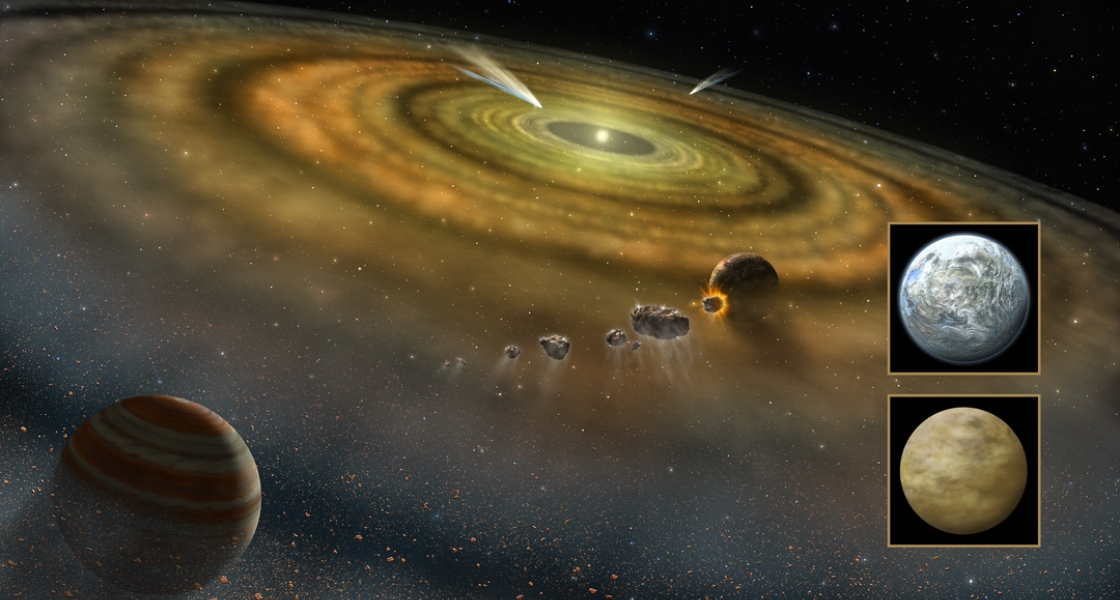The Solar System has a remarkable number of planets. It includes four rocky planets (Mercury, Venus, Earth, and Mars), four giant gaseous planets, and countless smaller worlds. Early on, there may even have been a fifth rocky planet that collided with the Earth, forming the Moon. We owe the survival of so many terrestrial planets (and our own evolution as a species) to the relatively stable orbits of Jupiter, Saturn, Uranus, and Neptune during the 100 million years it took to form the inner planets of the Solar System.
Most extrasolar planetary systems may not have been so fortunate. They show signs of being survivors of violent instabilities that knocked at least one giant planet completely out of the system. The worst instabilities would have resulted in the destruction of all the system’s rocky planets. Some “milder” instabilities left a single rocky planet intact, but badly shaken up. The survival of two or more rocky planets like those in our Solar System requires a stable set of giant gas and ice planets. And, theoretical calculations suggest that such stability may be relatively uncommon.
Only 15–25% of planetary systems around Sun-like stars end up with three or four terrestrial planets, according to a recent simulation by Fellow Phil Armitage and his colleagues at the Université de Bordeaux, Princeton University, Cambridge University, Weber State University, NASA Goddard Space Flight Center, and Boston University. These planetary systems had calm environments conducive to the formation and preservation of terrestrial planets. Most also still have large disks of dust and other debris in orbits beyond those of the system’s giant planets. These large debris disks mirror the favorable conditions for inner planet formation so well that Armitage and his colleagues say that bright cold dust emission around Sun-like stars could well serve as signposts of terrestrial planet formation.
A notable exception is our own Solar System. The Solar System’s outer region has a relatively meager collection of dust, rocks, and planetismals (rocky bodies a few kilometers or more in diameter) known as the Kuiper belt. The Kuiper belt’s relatively small size tells us something important about the Solar System’s unique history, Armitage says. About 700 million years after the birth of the Solar System, Uranus and Neptune moved far enough away from Jupiter and Saturn to interact with the then much-larger Kuiper belt. This interaction brought Uranus and Neptune into their present orbits. It also destabilized countless planetismals, hurtling many into outer space and others straight into the heart of the Solar System. This bombardment was responsible for some of the craters still visible today on the Moon. It must have inflicted even more damage on the Earth and Mars, and on the moons of the giant planets.
Despite the scars we see today, the bombardment came much too late to significantly affect the evolution of our Solar System’s inner planets. Fortunately for us, they remained stable. However, there is evidence that the bombardment increased the amount of wobble in the orbits of both Earth and Venus. On Earth, lulls in the rain of impacting comets and asteroids may even have allowed any primitive life forms to survive.




 The Physics Frontiers Centers (PFC) program supports university-based centers and institutes where the collective efforts of a larger group of individuals can enable transformational advances in the most promising research areas. The program is designed to foster major breakthroughs at the intellectual frontiers of physics by providing needed resources such as combinations of talents, skills, disciplines, and/or specialized infrastructure, not usually available to individual investigators or small groups, in an environment in which the collective efforts of the larger group can be shown to be seminal to promoting significant progress in the science and the education of students. PFCs also include creative, substantive activities aimed at enhancing education, broadening participation of traditionally underrepresented groups, and outreach to the scientific community and general public.
The Physics Frontiers Centers (PFC) program supports university-based centers and institutes where the collective efforts of a larger group of individuals can enable transformational advances in the most promising research areas. The program is designed to foster major breakthroughs at the intellectual frontiers of physics by providing needed resources such as combinations of talents, skills, disciplines, and/or specialized infrastructure, not usually available to individual investigators or small groups, in an environment in which the collective efforts of the larger group can be shown to be seminal to promoting significant progress in the science and the education of students. PFCs also include creative, substantive activities aimed at enhancing education, broadening participation of traditionally underrepresented groups, and outreach to the scientific community and general public.